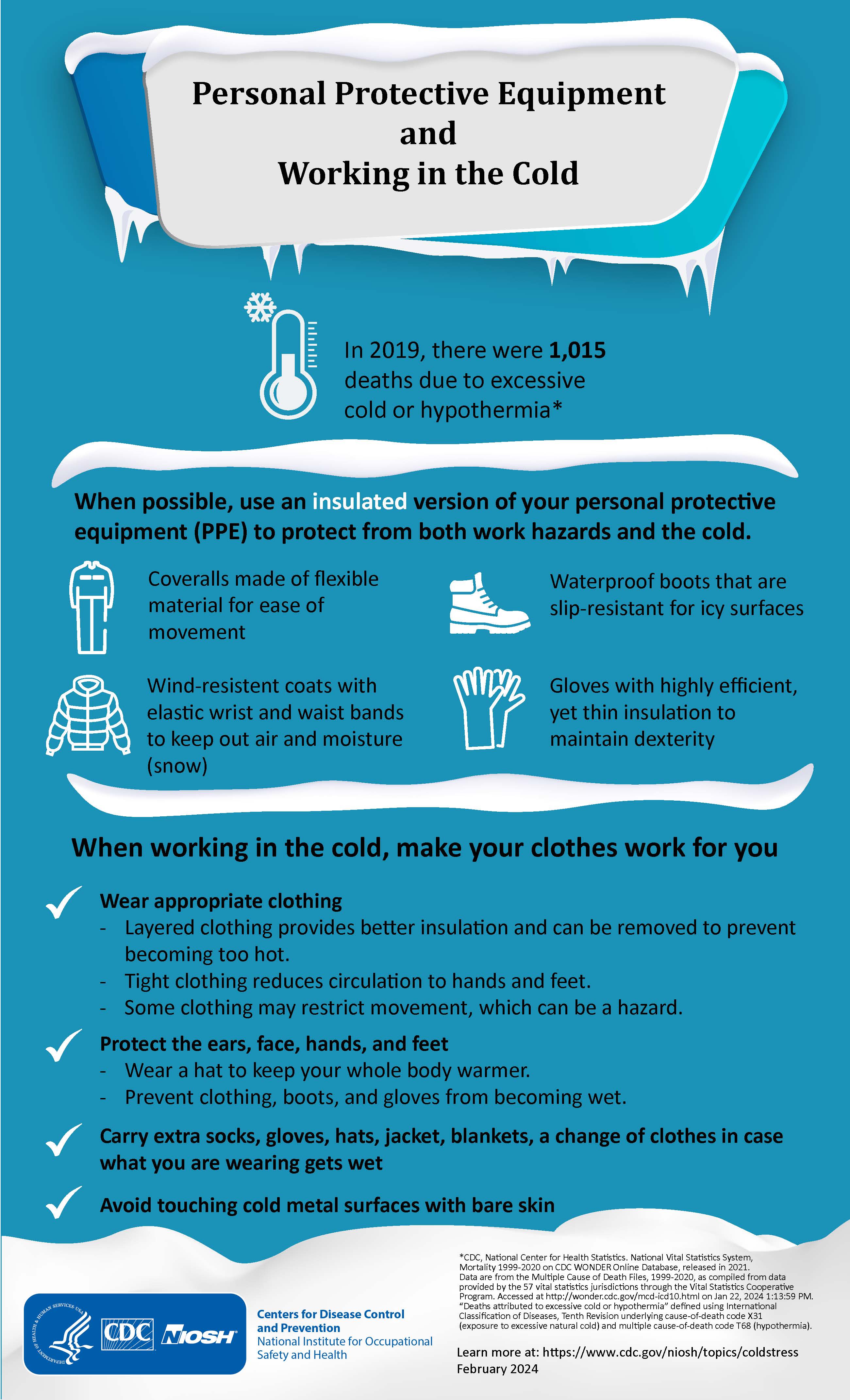The Physiological Response of Working in Cold Environments and how your PPE can Help
Posted on by
Recent NIOSH science blogs have discussed the physiological impact of wearing respirators. The first blog in this vein explored the Physiological Burden of Prolonged PPE Use on Healthcare Workers during Long Shifts, including potential CO2 buildup. A second blog addressed Heat Stress Imposed by PPE Worn in Hot and Humid Environments and how healthcare workers and their employers can recognize and mitigate potential stressors. As a third installment of this series, this blog addresses the general physiological responses to cold stress while working in cold environments and how personal protective equipment (PPE) can provide some protection.
Incidence of Hypothermia or Cold Injury
Due to the lack of a standardized reporting system, the true incidence of cold injury is not known, but appears to be uncommon across most of North America except in the northern tier states, including Alaska.
Many occupations require employees to work in cold outdoor environments (construction, first responders including search and rescue, North Sea oil and gas workers, etc.). Therefore, it is important to define cold stress and injury, identify the means to mitigate the exposure to cold, and provide immediate treatment for cold injury if necessary. Many of these occupations also require the use of PPE. This begs the question, what is the role of PPE in the mitigation of cold stress?
Definitions
Cold stress refers to environmental conditions (e.g., air temperature/humidity, windchill temperature, rain, and inadequate clothing for protection) in which body heat is lost to the environment at a rate that is faster than the body can produce heat. Consult the US Customary Windchill Chart, an integration of air temperature and wind velocity, to provide an estimate of the cooling power of the environment. (Note that persons riding in open vehicles may be subjected to dangerous wind chills even when the natural wind velocity is low).
Cold strain refers to the physiological responses (e.g., attempts to compensate for body heat loss through vascular changes, increased metabolic production of heat, and shivering) involved in preventing or limiting body heat loss. Cold stress may progress to cold injury and illness. Cold injuries may include hypothermia (clinical hypothermia is defined as a core body temperature falling below 96.8 ºF [35 ºC]), frostbite (freezing of tissue causing damage to the skin and perhaps underlying tissue, non-freezing injuries such as immersion foot (following reduction of blood flow after exposure to cold and wet environments which can cause nerve damage), chilblains (redness and swelling of skin of hands, face after exposure to cold), and cracked skin. As the victim becomes colder, they may experience muscle rigidity, reduced blood pressure, cardiovascular effects (rhythm disturbances) and a decrease in respiratory rate. Cold strain may also involve psychological impact to body heat loss, such as cognitive decline, poor judgement (paradoxical removal of clothing), and clouded consciousness.
Hypothermia: Symptoms and Treatment
 Early Symptoms
Early Symptoms
- Shivering – attempt to generate heat
- Fatigue
- Loss of coordination
- Confusion and disorientation
- Late Symptoms
- No shivering
- Blue skin
- Dilated pupils
- Slowed pulse & breathing
- Loss of consciousness
- Cardiac dysfunction, cardiac standstill (“flatline”) (established by medical professionals in an emergency department)
- Brain – Isoelectric EEG (“flatline”) (established by medical professionals in an emergency department).
For information about how to treat hypothermia, see the NIOSH Workplace Solutions document on Preventing Cold-related Illness, Injury, and Death among Workers.
Can PPE Help Protect Against Cold Strain?
PPE, as the last level of defense within the hierarchy of controls, is worn to protect against specific external hazards found in occupational settings. However, some PPE is, by its nature, highly insulative in addition to its other protective features. Therefore, wearing insulative PPE when available can be protective in cold environments if the PPE remains dry. Some examples of cold protective PPE are:
- Insulated coveralls, bunker gear, and jackets
- Insulated waterproof work boots and gloves
- Insulated hoods, facepieces, and goggles
Note: some PPE may increase susceptibility to both cold and heat injuries simultaneously: Some PPE is very tight fitting (gloves, facemask) thus increasing the chance for the development of frostbite. Moreover, highly insulating PPE worn while performing heavy work will result in a warm microclimate which can induce sweating. Once the physical activity stops, the sweat begins to evaporate causing further cooling which can contribute to cold stress.
Recommendations for Employers
Employers should take the following steps to protect workers from cold stress:
- Schedule preventive or planned maintenance and repair jobs in cold areas for warmer months.
- Schedule cold jobs for the warmer part of the day.
- Use relief workers or assign extra workers for long, demanding jobs in cold temperatures.
- Limit physical workload such that it will minimize sweating.
- Limit work schedules that require standing or sitting still for long periods of time in cold environments. Provide safe heat sources for these areas.
- Provide appropriate cold weather gear such as hats, gloves, and boots for work in cold environments.
- Provide wind protective clothing based on air velocities.
- Provide warm liquids to workers.
- Provide warm areas for use during work, break periods, and to change out of wet clothes.
- Monitor workers who are at risk of cold stress.
- Provide cold stress (cold environments that a worker may find themselves in) and cold strain (physiological response to cold) training that includes information about
- Worker risk
- Prevention
- Symptoms
- The importance of monitoring yourself and coworkers for symptoms
- Treatment
- Personal protective equipment (PPE)
While You Work, Make Your Clothes Work for You
When cold environments or temperatures cannot be avoided, here are some tips and techniques to protect workers from cold stress:
- Wear appropriate clothing.
- Wear several layers of loose clothing. Layering provides better insulation and allows removal of layers to prevent becoming too hot.
- Tight clothing reduces blood circulation. Warm blood needs to be circulated to the extremities.
- When choosing clothing, be aware that some clothing may restrict movement resulting in a hazardous situation. Choose clothing that allows free range of motion.
- Prevent clothing, boots, and gloves from becoming wet. Select waterproof options.
- Make sure to protect the ears, face, hands, and feet in extremely cold weather.
- Boots should be waterproof and insulated and in good working conditions. Cracks and tears may introduce water and cold.
-
- Wear a hat; it will keep your whole body warmer. Hats reduce the amount of body heat that escapes from your head. Ensure that any hats worn do not interfere with fit of other PPE such as hard hats of protective goggles. If necessary, wear a balaclava instead of a hat, which is close-fitting head covering and neck covering.
- Carry cold weather gear, such as extra socks, gloves, hats, jacket, blankets, and a change of clothes in case what you are wearing becomes wet.
In addition to utilizing clothes and/or blankets to keep warm, there are additional tips and considerations to keep warm:
- Avoid touching cold metal surfaces with bare skin.
- Carry a thermos of hot liquid.
- Move into warm locations during work breaks; limit the amount of time outside on extremely cold days.
- Include a thermometer and chemical hot packs in your first aid kit.
- Monitor your physical condition and that of your coworkers.
- Strong air movement (wind, non-heated electric fans) create an additional means for heat loss (“wind chill”). Therefore, workers should protect against exposure to wind in cold weather.
Find additional information on the NIOSH Working in the Cold webpage. The infographic above is available here.
Warren (Jon) Williams, PhD, is a research physiologist in the NIOSH National Personal Protective Technology Laboratory Research Branch
Jaclyn Krah Cichowicz, MA, is a health communications specialist in the NIOSH National Personal Protective Technology Laboratory Research Branch
*Infographic and text updated on 2/7/24
Resources
Cold Stress. American Council of Government Industrial Hygienists (ACGIH), 2018.
Parsons, K. Cold stress. In: Human Thermal Environments (2nd Edition) Parsons, K (Editor). Taylor and Francis, London, pp.293-325, 2003.
Zafren K, Giesbrecht G. State of Alaska Cold Injury Guidelines, Dept. of Health and Social Services, Division of Public Health, Section of Emergency Programs, Emergency Medical Services. Juneau, Alaska. 2014.
Prevention and Management of Cold-Weather Injuries. Technical Bulletin (TB MED 508). Department of the Army. April 2005.
Preventing Cold-related Illness, Injury, and Death among Workers https://doi.org/10.26616/NIOSHPUB2019113 DHHS (NIOSH) Publication No. 2019-113.
Posted on by

